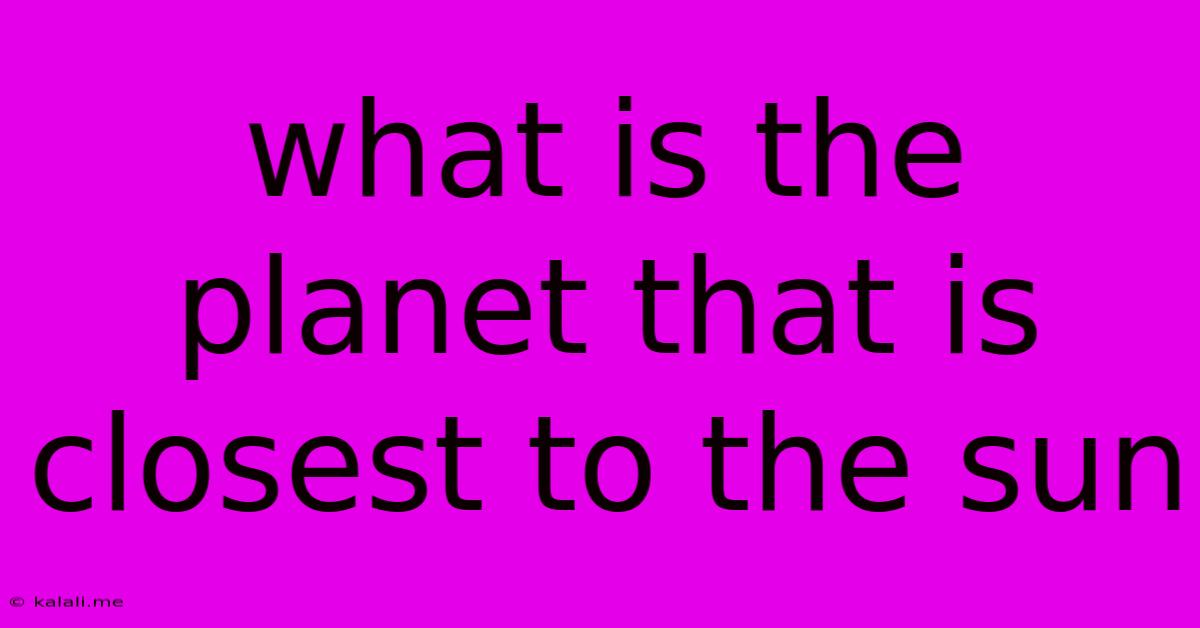What Is The Planet That Is Closest To The Sun
Kalali
Jun 07, 2025 · 3 min read

Table of Contents
What is the Planet Closest to the Sun? A Deep Dive into Mercury
Mercury is the planet closest to the sun. This scorching, rocky world holds a unique place in our solar system, captivating scientists and stargazers alike with its extreme conditions and fascinating characteristics. This article delves into the details of Mercury, exploring its orbit, surface features, and the challenges of studying this elusive planet.
Understanding Mercury's Proximity to the Sun
Located at an average distance of just 36 million miles (58 million kilometers) from the sun, Mercury completes one orbit in a mere 88 Earth days. This proximity leads to extreme temperatures, with surface temperatures soaring to 800 degrees Fahrenheit (430 degrees Celsius) during the day and plummeting to -290 degrees Fahrenheit (-180 degrees Celsius) at night. The significant temperature difference is due to the lack of a substantial atmosphere to regulate heat distribution. This close orbit also influences Mercury's unusual axial tilt and its peculiar rotation.
Key Features of Mercury:
-
Cratered Surface: Similar to our Moon, Mercury's surface is heavily cratered, a testament to its early bombardment by asteroids and comets. These impact craters, ranging in size from small pockmarks to vast basins, provide invaluable insights into the planet's geological history. The Caloris Basin, one of the largest impact structures in the solar system, is a particularly striking feature.
-
Scarps and Cliffs: Mercury’s surface is also characterized by long, impressive scarps – or cliffs – which are believed to be the result of the planet's core cooling and contracting over billions of years. This contraction caused the planet's surface to wrinkle and fold, creating these remarkable geological features.
-
Thin Exosphere: Mercury possesses a very thin exosphere, a tenuous atmosphere composed mainly of atoms blasted off its surface by the solar wind. This tenuous atmosphere offers little protection from the sun's intense radiation.
-
Magnetic Field: Despite its small size, Mercury surprisingly possesses a global magnetic field, although much weaker than Earth's. The origin of this magnetic field remains a subject of ongoing research and debate among planetary scientists. Its existence is vital in understanding the planet's internal structure and dynamics.
-
Lack of Moons: Unlike many other planets in our solar system, Mercury has no moons, adding to its unique characteristics.
Challenges in Studying Mercury:
Studying Mercury presents several challenges. Its proximity to the sun makes it difficult for spacecraft to approach and maintain stable orbits, requiring precise trajectory calculations and sophisticated engineering solutions. The intense solar radiation also poses a significant threat to electronic equipment.
Missions to Mercury:
Several robotic missions have been sent to study Mercury, most notably NASA's MESSENGER (MErcury Surface, Space ENvironment, GEochemistry, and Ranging) spacecraft, which orbited Mercury from 2011 to 2015, providing a wealth of data about the planet's composition, geology, and magnetic field. The European Space Agency (ESA) and the Japan Aerospace Exploration Agency (JAXA) are also collaborating on the BepiColombo mission, currently en route to Mercury, designed to further enhance our understanding of this fascinating inner planet.
Conclusion:
Mercury, the closest planet to the sun, remains an enigma, albeit a fascinating one. Its extreme conditions, unique geological features, and intriguing magnetic field continue to captivate scientists and drive further exploration and research. Future missions promise to unlock even more of its secrets, providing a deeper understanding of planetary formation and evolution within our solar system.
Latest Posts
Latest Posts
-
How Long Wait To Paint Pressure Treated Wood
Jun 07, 2025
-
How To Remove Scratches From Hardwood
Jun 07, 2025
-
Can You Put Coffee Grounds In The Garbage Disposal
Jun 07, 2025
-
Hooking Up Dishwasher To Garbage Disposal
Jun 07, 2025
-
How Many Years Is In A Score
Jun 07, 2025
Related Post
Thank you for visiting our website which covers about What Is The Planet That Is Closest To The Sun . We hope the information provided has been useful to you. Feel free to contact us if you have any questions or need further assistance. See you next time and don't miss to bookmark.